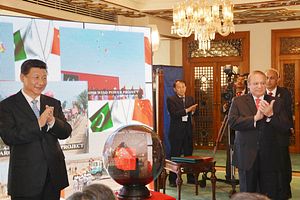On May 14 and 15, China hosted an international summit in Beijing devoted to the “One Belt, One Road” (OBOR) project, referring to overland and maritime routes across the Eurasian landmass. One of the most significant moments of the summit was the meeting of the Chinese and Pakistani leaders, resulting in newly signed agreements adding nearly $500 million in deals to the $57 billion already pledged for the China-Pakistan Economic Corridor (CPEC). During the event, Pakistani Prime Minister Nawaz Sharif is supposed to have held meetings with the leaders of Kazakhstan, Uzbekistan, and Kyrgyzstan to persuade them to invest in the CPEC project, a network of rail, road, and energy infrastructure linking Pakistan’s Gwadar port with western China.
CPEC, formally unveiled in April 2015, has been highlighted as a flagship project under the OBOR initiative. As Eurasia Review put it, CPEC “has become the foremost bilateral initiative between China and Pakistan, entailing a budget above $46 billion.” Nearly all policymakers in Pakistan see the China-Pakistan Economic Corridor as an effective tool, as it would greatly boost the economy of Pakistan. For China, the project would ease its mutual connectivity problem with the Persian Gulf region, Africa, Europe, as well as the Central Asian region.
As a landlocked but resource rich region, Central Asian countries have always looked to access regional markets, including Pakistan, China, India, and the countries of West Asia. In this regard, CPEC could serve as a strategic opportunity for Turkmenistan, Uzbekistan, Kyrgyzstan, and Tajikistan to transport their goods and market them more competitively to regional and global markets. Pakistan also desires to access the rich resources of Central Asia via Afghanistan to meet its energy needs, as well as transport goods to Central Asia.
China has been a key driver of infrastructure investment and construction in Central Asia since the mid-1990s. Chinese state-owned companies have built highways, railways, bridges, and telecommunication systems in Tajikistan, Kyrgyzstan, and Uzbekistan. China’s economic strategy in South and Central Asia is based on the assumption that building up economic prosperity in the region will help alleviate the threat posed by local radical Islamist groups. CPEC would be a natural extension of that strategy. Also, by connecting Central Asian countries with CPEC, China intends to cultivate new markets with significant growth potential in the region and evolve goodwill with neighboring countries.
In this context, several Central Asia countries have welcomed the implementation of the CPEC project. Turkmenistan’s President Gurbanguly Berdimuhamedov discussed CPEC with Pakistan’s Sharif in March 2016, emphasizing the role of the project in promoting progress and prosperity. Berdimuhamedov’s enthusiasm should not come as a surprise, as his country is allowed to use the crown jewel of CPEC, the newly modernized Gwadar deep-sea port in Pakistan, which gives Turkmenistan access to the Indian Ocean.
Tajikistan is also eyeing access to Gwadar port, as it would be a junction to connect the landlocked Central Asian state with the rest of world. However, there is currently a lack of significant connections, whether roads or railways, between Dushanbe and Islamabad. Ultimately, Tajikistan may provide a road linking Pakistan with other Central Asian countries through Murghab province in Tajikistan. But that will require the construction of a new highway, due to the latter’s mountainous location.In 2015, Tajik President Emomali Rahmon and Nawaz Sharif approved three new highway projects linking their countries and connected to the broader CPEC framework.
Deputy Prime Minister of Uzbekistan Ulugbek Rozukulov expressed a similarly supportive stance during his official visit to Islamabad in December 2016. The participation of energy-rich Uzbekistan in the CPEC project has the potential to double Pakistan’s energy output for the next six years, ensuring the country with permanent access to electricity.
Kazakhstan is also seemingly eager to launch joint projects under CPEC In 2015, then-Prime Minister Karim Massimov highlighted the importance of the CPEC project for Kazakhstan and the Central Asian region.
Although, CPEC promises a lot of benefits for involved countries’ future economic growth, the regional security issue remains a major concern for China and Central Asian countries. The main stumbling block in deepening multilateral relations between Central Asia, China, and Pakistan is the worsening situation in Afghanistan. The exchange of goods and energy from Central Asia to Pakistan is highly dependent on the normalization process in Afghanistan, since the shortest route for Central Asian countries to connect with Gwadar port in Pakistan would require traversing Afghan soil. Moreover, the fact that much of the infrastructure investment of CPEC is slated to run through Pakistan’s most insecure and politically fraught provinces — Khyber Pakhtunkhwa and Balochistan, where Gwadar port is located — offers more potential losses to partners from Central Asia.
Fuad Shahbazov is an Expert-Advisor of the Foreign Policy Analysis Department at the Baku-based Center for Strategic Studies.

































